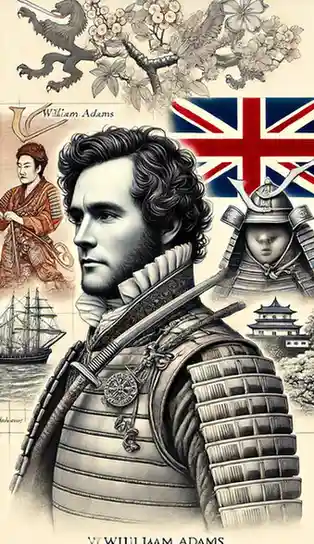The story of William Adams, the first European samurai, has captivated many with the release of the Shogun miniseries, sparking fascination with the interactions between Europeans and Japanese during the 1600s. For many, the character of John Blackthorne must be fascinating, to be one of the first Europeans to set foot in Japan and to become a respected Samurai. But while John is a work of fiction, he is based on a real man.
Story of William Adams Samurai
William Adams, also known as “Miura Anjin” in Japan, was a remarkable figure whose life bridged two vastly different worlds. Born in Gillingham, England in 1564, Adams embarked on a journey that allowed him to become one of the first Europeans to set foot in Japan and one of the only Westerners to become a samurai.
His journey began in 1598 when acted as a pilot for the ship “Liefde”. In the age of sail, traveling by sea was a perilous undertaking with storms and sickness ravaging the crew. Of the 100 crew who set out, only about 23 remained by the time they reached Japan.
The ship docked in Kyushu where they were arrested by the local Daimyo who reported these people to the ruling regent council. This council seized their cargo and initially wanted to execute them as pirates, but someone intervened, Tokugawa Ieyasu who was a part of this council, and recognized their knowledge and talents in shipbuilding.
He would invite Adams and the grew to his capital of Edo. There Adams would train Tokugawa’s army in firing cannons after taking them from the Liefde. This knowledge would help Tokugawa reunite Japan in the Battle of Sekigahara.
After this battle, Tokugawa forbade the crew from returning home. Instead, he offered them a comfortable life in Japan, giving them a rice allowance and land to settle on in exchange for acting as teachers and advisors.
Under William Adams guidance, he would help construct ships and train Japan’s navy in new sailing techniques. For his service, Adams would be made a samurai. He would continue to remain in Tokugawa’s court, acting as an advisor until he died at the age of 55.
A description of this early meeting could be found in a letter.
“Coming before the king, he viewed me well, and seemed to be wonderfully favourable. He made many signs unto me, some of which I understood, and some I did not. In the end, there came one that could speak Portuguese. By him, the king demanded of me of what land I was, and what moved us to come to his land, being so far off. I showed unto him the name of our country, and that our land had long sought out the East Indies, and desired friendship with all kings and potentates in way of merchandise, having in our land diverse commodities, which these lands had not…
“Then he asked whether our country had wars? I answered him yea, with the Spaniards and Portugals, being in peace with all other nations. Further, he asked me, in what I did believe? I said, in God, that made heaven and earth. He asked me diverse other questions of things of religions, and many other things: As what way we came to the country. Having a chart of the whole world, I showed him, through the Strait of Magellan. At which he wondered, and thought me to lie. Thus, from one thing to another, I abode with him till mid-night.
– William Adams
William Adams Influence

William Adams influence in Japan extended far beyond his unique position as a European samurai. His expertise in shipbuilding and navigation introduced pivotal maritime advancements to Japan, shaping the nation’s naval capabilities. Adams’s knowledge of European ship designs and sailing techniques significantly enhanced the efficiency and strength of Japanese ships. He supervised the construction of Western-style vessels, which were instrumental in Japan’s maritime expansion and defense strategies.
Adams role as a teacher and advisor went beyond shipbuilding; he educated the Japanese on various aspects of navigation, mapmaking, and even gunnery. His contributions were crucial during a time when Japan was emerging from centuries of civil strife and consolidating power under Tokugawa Ieyasu. The Battle of Sekigahara, where Adams’s knowledge of artillery played a role, was a decisive conflict that led to the unification of Japan.
William Adams legacy in Japan is a testament to the impact of cultural and technological exchange. His ability to bridge two very different cultures and his contributions to Japan’s naval prowess highlight the importance of knowledge sharing and adaptation in history.
If you want to create vintage letters that look fit for the Shogun, our Vintage Letter platform can let you create some beautiful letters that you can try here.
